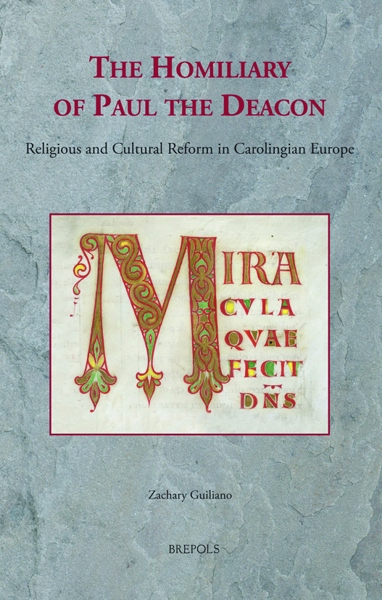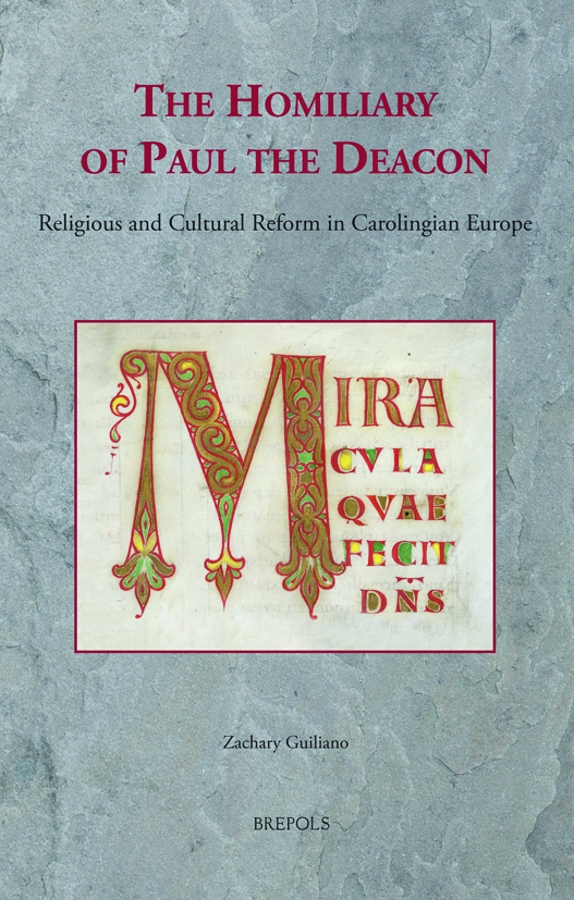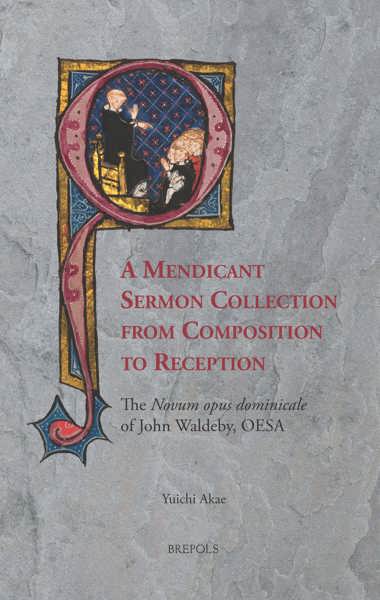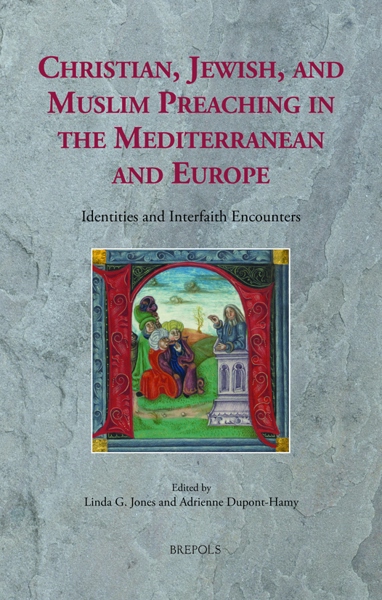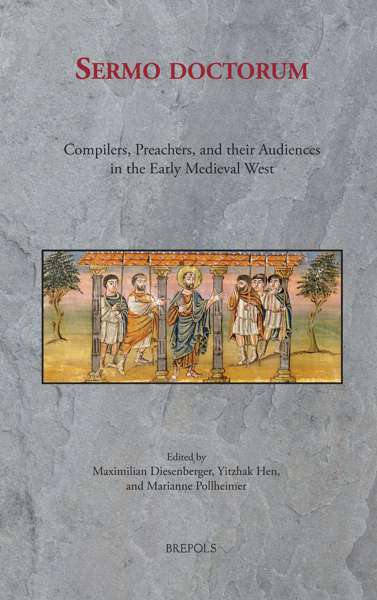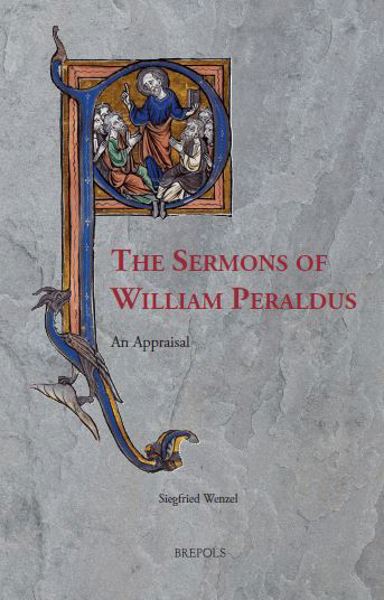
The Homiliary of Paul the Deacon
Religious and Cultural Reform in Carolingian Europe
Zachary Guiliano
- Pages: 339 p.
- Size:156 x 234 mm
- Illustrations:1 b/w, 3 col., 13 tables b/w., 1 maps b/w
- Language(s):English, Latin
- Publication Year:2021
- € 90,00 EXCL. VAT RETAIL PRICE
- ISBN: 978-2-503-57791-3
- Hardback
- Available
- € 90,00 EXCL. VAT RETAIL PRICE
- ISBN: 978-2-503-57792-0
- E-book
- Available
2023 Ecclesiastical History Society's Book Prize for a first monograph
An ambitious examination of one of the most important theological and liturgical texts of the Middle Ages — the homiliary of Paul the Deacon commissioned by Charlemagne — and the first comprehensive study of its earliest witnesses, a resource for all those interested in Charlemagne, medieval liturgy, theology, and preaching.
“This is an important work, written to the highest standards of scholarship, which will long have an influence upon the specific importance of the Homiliary but also point the way towards the real day-by-day significance of the reforms and intent behind the aulic programme of Charlemagne. The series editors, the publishers and the author should all be congratulated on the publication of such an important and fine work.” (Christopher Heath, in The Medieval Review, 23/02/2022)
“Ich (...) möchte aber abschliessend noch einmal betonen, dass G. mit diesem Buch eine nützliche und gut lesbare Arbeit vorgelegt hat, die all jene interessieren dürfte, die sich mit der Geschichte, Kultur und Theologie der Karolingerzeit sowie mit homiletischen Texten beschäftigen.” (Lukas J. Dorfbauer, in Theologische Literaturzeitung, 146 (2021) 12, p. 1225-1226)
“This is a model of what a monograph should be. It is a groundbreaking (…)” (Rod Thomson, in Parergon, 39/1, 2022, p. 246)
“The depth of scholarship within this collection is impressive, as is the exploration of terms, places, and concepts not covered previously.” (Anthony J. Watson, in Church History, June 2022, p. 377)
“Guiliano delivers a thought-provoking overview of Paul’s homiliary. He provides a valuable service in revisiting and updating our understanding of the organization, the central concerns, and the transmission of this seminal work of the Carolingian Renewal. (…) The book will be of interest to scholars of the early Middle Ages, the history of liturgy, the history of Christianity, and book history. Guiliano’s study makes possible and will support much future work on Paul’s homiliary.” (Owen M. Phelan, in Early Medieval Europe, 33/1, 2023, p. 159)
“(..) Zachary Guiliano’s absorbing book sheds a flood of new light on its making and significance. He tackles big topics such as the nature of royal patronage, the cost of material resources, complexities of communication, and the reception of Paul’s text, as well as the nature of its theological contents. All this rests on an impressively solid research basis; throughout, analysis and argument are detailed, methodical, lucid, and illuminating. In particular, the tabular summaries of manuscript research results are very helpful for the reader.” (Stuart Airlie, in Speculum: A Journal of Medieval Studies, 99/3, 2024, p. 911)
“...Guiliano’s monograph is a commendable addition to the field ofmedieval studies. The monograph’s clear and engaging style makes it a compellingwork in the study of medieval homiliaries and their significance in the Carolingian period and beyond.” (David Mesquita, in Euphrosyne. Journal for Classical Philology, 51, 2023, p. 514)
The Revd Dr Zachary Guiliano is chaplain and career development research fellow at St Edmund Hall, Oxford. He is the author of various articles, essays, and reviews in theology and church history.
As one of the most widely used products of Charlemagne’s religious and cultural reforms, the homiliary of Paul the Deacon is a unique monument in the history of Western Europe. Completed around AD 797, this collection of patristic homilies and sermons shaped the religious faith and liturgical practices of the churches in Carolingian Europe and those of countless other churches over the course of a millennium of use.
Until now, scholarly study of the homiliary has rested on seven partial witnesses to the collection. This study, however, draws on over 80 newly identified witnesses from the Carolingian period, while providing a brief guide and handlist to hundreds of later manuscripts. It replaces the current scholarly reconstruction of the homiliary, discusses the significance of the collection’s liturgical structure and provisions, and considers the composition of the homiliary in the context of Charlemagne’s reforms and Paul’s patron-client relationships. The study also brings together evidence for the production and use of this text in thirty-three Carolingian monasteries, cathedrals, and churches.
The book then addresses the homiliary’s theological character: the contents of the homiliary reflected a concern for expressing and defending orthodox doctrine at Charlemagne’s court against Trinitarian and Christological heresies, as well as an urgent attention to moral reform in the light of a belief in the imminence of divine judgement. Finally, the study demonstrates the varied uses of Paul’s collection and its historical legacy.
Introduction
- 0.1: The homiliary in scholarship: editions and reconstructions
- 0.2: The homiliary in scholarship: The nature of the Epistola Generalis
- 0.3: The homiliary in scholarship: The history of preaching
- 0.4: The homiliary in scholarship: Anglo-Saxon England
- 0.6: Manuscript identifications and the advent of digital research
- 0.7: The Carolingian witnesses to Paul’s homiliary
- 0.8: Outline of the Book’s Argument
- 1.1: The manuscript base
- 1.2: General features of the extant manuscripts
- 1.3: The witnesses transmitting the prefatory material and Carolingian witnesses
- 1.4: The original structure of PD: the winter volume
- 1.5: The winter volume: contested entries
- 1.6: The original structure of PD: the summer volume
- 1.7: Conclusion
- 2.1: ‘Individual Sundays and the rest of the divine feasts’
- 2.2: The sanctoral cycle
- 2.3: The purpose of a limited sanctoral cycle
- 2.4: ‘Diverse fasts’ and other occasions
- 2.5: The greater and lesser litanies
- 2.6: In traditione symboli: Catechesis and creed in Lent
- 2.7: Anniversaries of death
- 2.8: The Sundays after Pentecost
- 2.9: Paul’s work, the Christian year, and the influence of other liturgical books
- 2.10: A specific liturgical year? (786–787 and 797–798)
- 2.11: Conclusion
- 2.12: Outline of the Winter Volume: Advent to Holy Saturday
- 2.13: Outline of the Summer Volume (A): Easter to Saint Matthew
- 2.14: Outline of the Summer Volume (B): Commune sanctorum (The Common of Saints)
- 3.1: Paul’s representation of his work in the preface
- 3:2: The dedicatory verse (Summo apici rerum)
- 3.3: The prefatory letter (Epistola Generalis)
- 3.4: The descriptive introduction (Incipiunt omeliae)
- 3.5: The homiliary’s organisational features: Rubrics, readings, authors
- 3.6: The collection’s contents: Homilies and sermons from surprising Fathers
- 3.7: The origins of Paul’s texts: The state of Carolingian libraries
- 3.8: A wandering monk? Paul on the road and in the scriptorium
- 3.9: Paul and patronage, earthly and heavenly
- 3.10: Dating Paul’s collection: the late 790s
- 4.1: The Epistola Generalis and dissemination
- 4.2: Capitulary legislation and the homiliary’s dissemination
- 4.3: Manuscript production, the physical constraints on dissemination
- 4.4: Difficulties for ‘mass production’: The example of Tours, the setting of the court
- 4.5: Varied evidence for dissemination
- 4.6: Literary evidence
- 4.7: St Wandrille and Benediktbeuern
- 4.8: St Riquier
- 4.9: Lorsch
- 4.10: St Gall
- 4.11: Reichenau
- 4.12: Bobbio
- 4.13: Passau
- 4.14: Monte Cassino
- 4.15: St Calixtus
- 4.16: Fulda
- 4.17: Lyon
- 4.18: Weissenburg
- 4.19: Many inconclusive references, but 14 probable
- 4.20: Manuscript evidence (A): 22 clear palaeographical identifications, 12 unclear
- 4.21: Manuscript Evidence (B): Transmission of textual variants implies further copies
- 4.22: Textual variants in the summer volume
- 4.23: Textual variants in the winter volume
- 4.24: Paul’s two volumes often circulated separately
- 4.25: Conclusion
- 5.1: The emphases of the collection: Gospel exegesis, doctrinal sermons
- 5.2: The Bible in Paul’s collection: texts and theory
- 5.3: The Admonitio Generalis and Carolingian theology
- 5.4: God the Trinity
- 5.5: Definitions of the Trinitarian relations
- 5.6: Christology and Chalcedon
- 5.7: Looser Christological formulations: Origen and ‘Maximus II’
- 5.8: Eschatology
- 5.9: Gregory the Great on the impending judgment
- 5.10: The resurrection of the dead: Flesh and hope
- 5.11: Eschatology in PD and the Admonitio Generalis
- 5.12: Ethics and imitation
- 5.13: Christian ethical practices: fasting, confession, almsgiving, care for the dead
- 5.14: Conclusion
- 6.1: Crafting new collections
- 6.2: Amplified homiliaries (a): more of Paul’s ‘canon’ of Fathers
- 6.3: Expanded homiliaries (b): more Augustine
- 6.4: Expanded homiliaries (c): new authors, new collections
- 6.5: Abbreviated homiliaries (a): one entry per occasion
- 6.6: Abbreviated homiliaries (b): special feast days only
- 6.7: Abbreviated homiliaries (c): Sundays only
- 6.8: Abbreviated homiliaries (d): saints only
- 6.9: Abbreviated homiliaries (e): sermons only
- 6.10: Extraction
- 6.11: Abbreviated readings
- 6.12: Decorated texts and the ‘economy’ of monasticism
- 6.13: Private study or meditation?
- 6.14: Dwellings and travel of intellectual elite in places PD was known
- 6.15: Study and annotation
- 6.16: Private study certain
- 6.17: Preaching and regulatory material (capitularies, councils, statutes, rules)
- 6.18: Preaching and the manuscript evidence
- 6.19: Liturgical reading
- 6.20: Liturgical reading and manuscript evidence
- 6.21: Other uses: storing prayers and community memory
- 6.22: Conclusion
Appendix 1: Paul’s dedicatory verse, Summo apici rerum
Appendix 2: Charlemagne’s prefatory letter, the Epistola generalis
Appendix 3: the descriptive introduction, incipiunt omeliae
Appendix 4: Paul’s laudatory verse, Utere felix
Appendix 5: Critical edition of crucial rubrics PD
Appendix 6: The manuscript witnesses of Paul the Deacon’s homiliary
Bibliography
Index of Manuscripts
General Index
